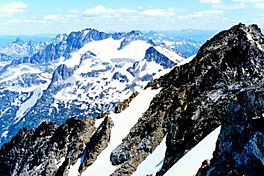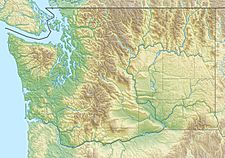Fremont Glacier (Washington) facts for kids
Quick facts for kids Fremont Glacier |
|
|---|---|

Fremont Glacier seen from Mount Buckner
|
|
| Type | Mountain glacier |
| Location | North Cascades National Park, Skagit County, Washington, United States |
| Coordinates | 48°31′47″N 120°57′26″W / 48.52972°N 120.95722°W |
| Length | .5 mi (0.80 km) |
| Terminus | Icefall |
| Status | Retreating |
Fremont Glacier is a large sheet of ice located high up on the southeast side of Mount Logan. This mountain is found in the beautiful North Cascades National Park in Washington, one of the U.S. states. The glacier is about half a mile (0.5 mi) long. However, it is nearly one mile (1 mi) wide! It flows down from near the top of Mount Logan to an elevation of about 7,200 feet (2,200 m).
Contents
What is Fremont Glacier?
Fremont Glacier is a type of mountain glacier. Glaciers are huge bodies of ice that move very slowly over land. They form when snow falls and piles up over many years. The weight of new snow presses down on older snow, turning it into ice. This ice then starts to flow downhill because of gravity.
Where is Fremont Glacier Located?
Fremont Glacier is nestled in the North Cascades National Park. This park is in Skagit County, Washington, which is in the state of Washington, USA. The North Cascades are known for their rugged mountains and many glaciers. Fremont Glacier sits on the slopes of Mount Logan, a tall peak in this range.
How Big is Fremont Glacier?
Even though it's called a "glacier," Fremont Glacier isn't as long as some others. It measures about 0.5 miles (0.8 km) from top to bottom. But what makes it special is how wide it is. It stretches out to almost 1 mile (1.6 km) across! This wide shape means it covers a large area on the side of Mount Logan. It flows down to an elevation of about 7,200 feet (2,200 m) above sea level.
Why are Glaciers Important?
Glaciers like Fremont Glacier are very important for several reasons. They act like giant frozen reservoirs, storing fresh water. When the ice melts slowly during warmer months, it feeds rivers and streams. This water is vital for plants, animals, and even people living downstream. Glaciers also help us understand Earth's climate history. Scientists study them to see how the climate has changed over thousands of years.
Retreating Glaciers
The status of Fremont Glacier is "retreating." This means the glacier is getting smaller. It is melting faster than new snow can build it up. Many glaciers around the world are retreating. This is often a sign of a warming climate. When glaciers shrink, it can affect water supplies and ecosystems. Scientists watch glaciers closely to learn more about climate change.


